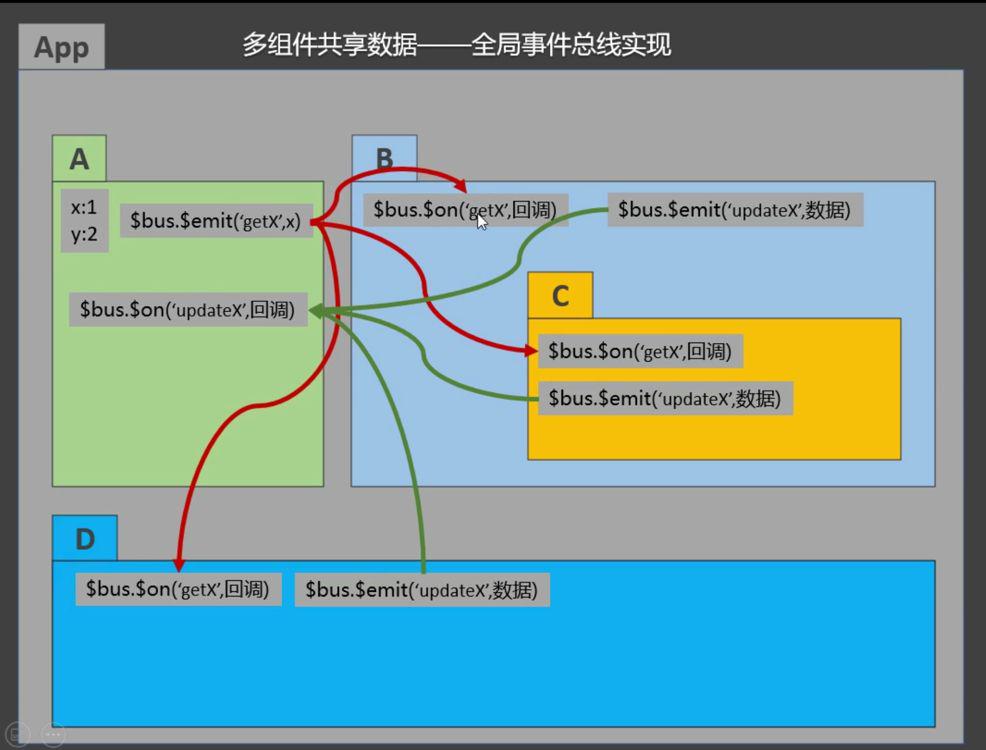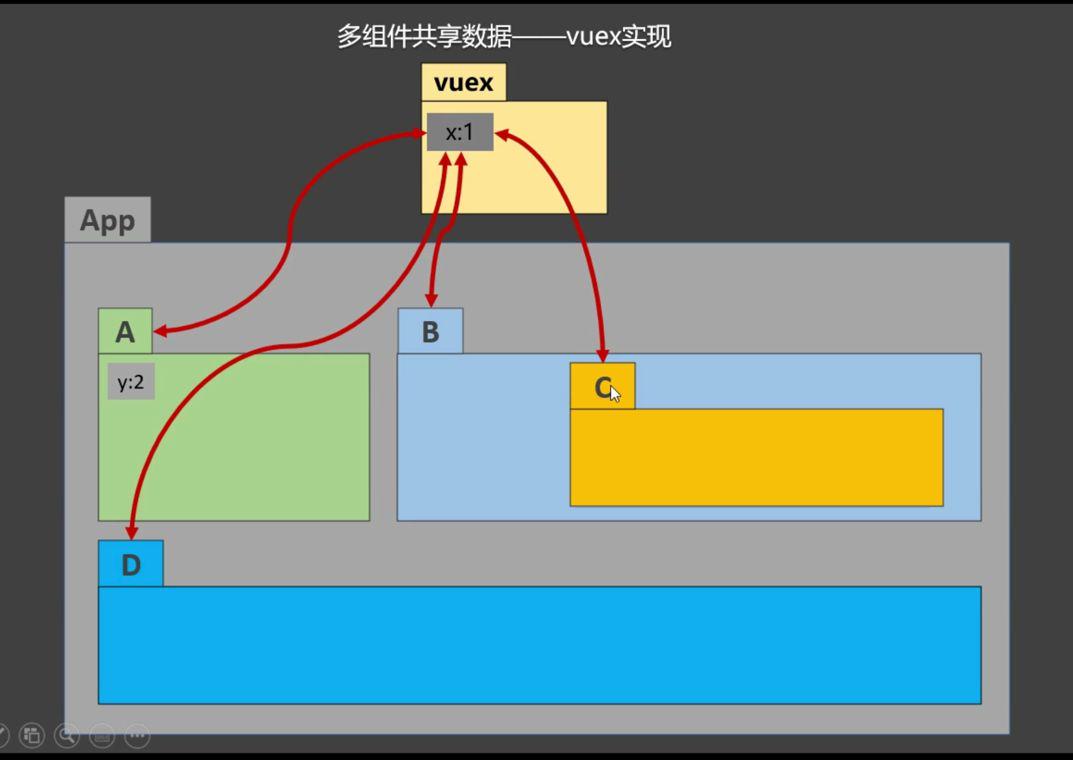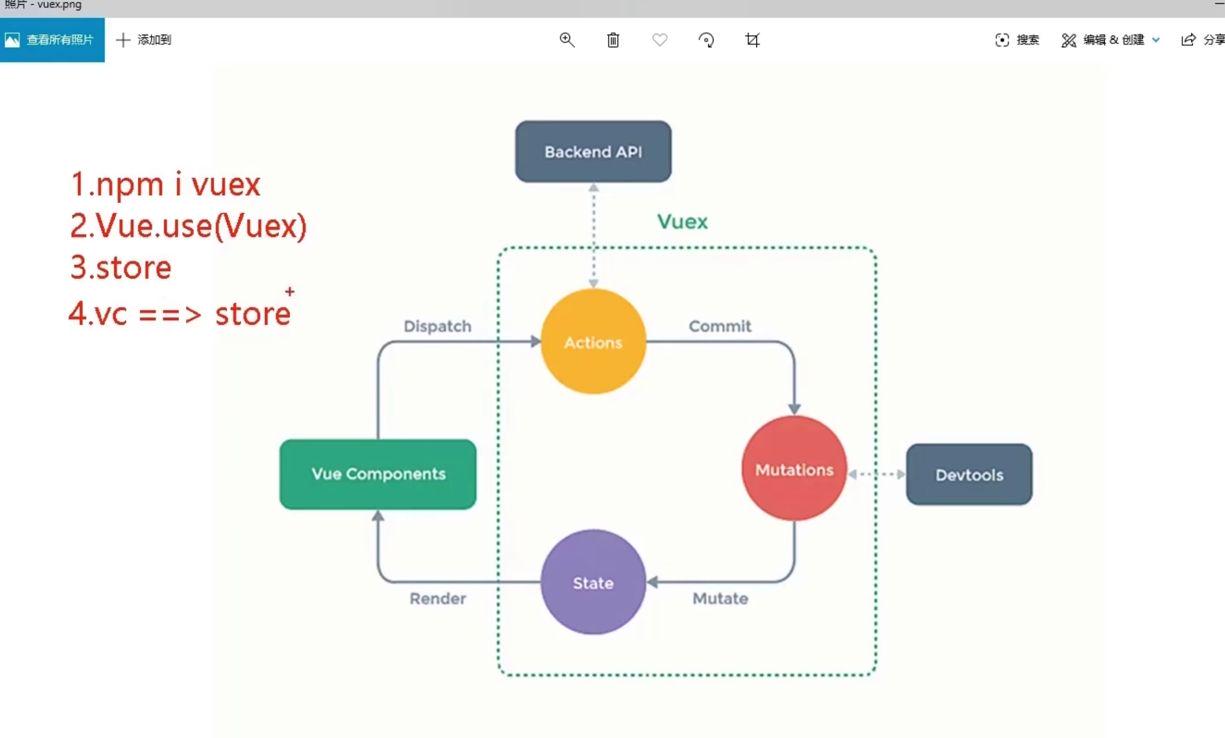实现组件间的通信(数据传递)的方案:
1、props配置项
2、组件的自定义事件
3、全局事件总线
4、消息订阅与发布(pubsub)
5、插槽
6、VueX
7、通过路由
props配置项
功能:让组件接收外部传过来的数据
传递数据:
若单向父向子传递数据:<Demo name="xxx"/>
配合路由实现。
接收数据:
第一种方式(只接收):props:['name']
第二种方式(限制类型):props:{name:String}
第三种方式(限制类型、限制必要性、指定默认值):
props:{
name:{
type:String, //类型
required:true, //必要性
default:'老王' //默认值
}
}备注:props是只读的,Vue底层会监测你对props的修改,如果进行了修改,就会发出警告,若业务需求确实需要修改,那么请复制props的内容到data中一份,然后去修改data中的数据。
组件的自定义事件
一种组件间通信的方式,适用于:子组件 ===> 父组件
使用场景:
A是父组件,B是子组件,B想给A传数据,那么就要在A中给B绑定自定义事件(事件的回调在A中 )。
绑定自定义事件:
第一种方式,在父组件中:<Demo @atguigu="test"/> 或 <Demo v-on:atguigu="test"/>
第二种方式,在父组件中:
<Demo ref="demo"/>
......
mounted(){
this.$refs.xxx.$on('atguigu',this.test)
}若想让自定义事件只能触发一次,可以使用once修饰符,或$once方法。
触发自定义事件:this.$emit('atguigu',数据)
解绑自定义事件:this.$off('atguigu')
组件上也可以绑定原生DOM事件,需要使用native修饰符。
注意:通过this.$refs.xxx.$on('atguigu',回调)绑定自定义事件时,回调要么配置在methods中 ,要么用箭头函数 ,否则this指向会出问题!
全局事件总线(GlobalEventBus)
一种组件间通信的方式,适用于任意组件间通信 。

安装全局事件总线:
new Vue({
......
beforeCreate() {
Vue.prototype.$bus = this //安装全局事件总线,$bus就是当前应用的vm
},
......
}) 使用事件总线:
接收数据:A组件想接收数据,则在A组件中给$bus绑定自定义事件,事件的回调留在A组件自身。
methods(){
demo(data){......}
}
......
mounted() {
this.$bus.$on('xxxx',this.demo)
}提供数据:this.$bus.$emit('xxxx',数据)
最好在beforeDestroy钩子中,用$off去解绑当前组件所用到的 事件。
消息订阅与发布(pubsub)
一种组件间通信的方式,适用于任意组件间通信 。
使用步骤:
安装pubsub:npm i pubsub-js
引入: import pubsub from 'pubsub-js'
接收数据:A组件想接收数据,则在A组件中订阅消息,订阅的回调留在A组件自身。
methods(){
demo(data){......}
}
......
mounted() {
this.pid = pubsub.subscribe('xxx',this.demo) //订阅消息
}提供数据:pubsub.publish('xxx',数据)
最好在beforeDestroy钩子中,用PubSub.unsubscribe(pid)去取消订阅。
插槽
作用:让父组件可以向子组件指定位置插入html结构,也是一种组件间通信的方式,
适用于 父组件 ===> 子组件 。
分类:默认插槽、具名插槽、作用域插槽
使用方式:
默认插槽:
父组件中:
<Category>
<div>html结构1</div>
</Category>
子组件中:
<template>
<div>
<!-- 定义插槽 -->
<slot>插槽默认内容...</slot>
</div>
</template>具名插槽:
父组件中:
<Category>
<template slot="center">
<div>html结构1</div>
</template>
<template v-slot:footer>
<div>html结构2</div>
</template>
</Category>
子组件中:
<template>
<div>
<!-- 定义插槽 -->
<slot name="center">插槽默认内容...</slot>
<slot name="footer">插槽默认内容...</slot>
</div>
</template>作用域插槽:
理解:数据在组件的自身,但根据数据生成的结构需要组件的使用者来决定。 (games数据在Category组件中,但使用数据所遍历出来的结构由App组件决定)
具体编码:
父组件中:
<Category>
<template scope="scopeData">
<!-- 生成的是ul列表 -->
<ul>
<li v-for="g in scopeData.games" :key="g">{
{g}}</li>
</ul>
</template>
</Category>
<Category>
<template slot-scope="scopeData">
<!-- 生成的是h4标题 -->
<h4 v-for="g in scopeData.games" :key="g">{
{g}}</h4>
</template>
</Category>
子组件中:
<template>
<div>
<slot :games="games"></slot>
</div>
</template>
<script>
export default {
name:'Category',
props:['title'],
//数据在子组件自身
data() {
return {
games:['红色警戒','穿越火线','劲舞团','超级玛丽']
}
},
}
</script>Vuex
1.概念
在Vue中实现集中式状态(数据)管理的一个Vue插件,对vue应用中多个组件的共享状态进行集中式的管理(读/写),也是一种组件间通信的方式,且适用于任意组件间通信。

2.何时使用?
多个组件需要共享同一数据时
3.搭建vuex环境
创建文件:src/store/index.js
//引入Vue核心库
import Vue from 'vue'
//引入Vuex
import Vuex from 'vuex'
//应用Vuex插件
Vue.use(Vuex)
//准备actions对象——响应组件中用户的动作
const actions = {}
//准备mutations对象——修改state中的数据
const mutations = {}
//准备state对象——保存具体的数据
const state = {}
//创建并暴露store
export default new Vuex.Store({
actions,
mutations,
state
})在main.js中创建vm时传入store配置项
......
//引入store
import store from './store'
......
//创建vm
new Vue({
el:'#app',
render: h => h(App),
store
})4.基本使用

初始化数据、配置actions、配置mutations,操作文件store.js
//引入Vue核心库
import Vue from 'vue'
//引入Vuex
import Vuex from 'vuex'
//引用Vuex
Vue.use(Vuex)
const actions = {
//响应组件中加的动作
jia(context,value){
// console.log('actions中的jia被调用了',miniStore,value)
context.commit('JIA',value)
},
}
const mutations = {
//执行加
JIA(state,value){
// console.log('mutations中的JIA被调用了',state,value)
state.sum += value
}
}
//初始化数据
const state = {
sum:0
}
//创建并暴露store
export default new Vuex.Store({
actions,
mutations,
state,
})组件中读取vuex中的数据:$store.state.sum
组件中修改vuex中的数据:$store.dispatch('action中的方法名',数据) 或 $store.commit('mutations中的方法名',数据)
备注:若没有网络请求或其他业务逻辑,组件中也可以越过actions,即不写dispatch,直接编写commit
5.getters的使用
概念:当state中的数据需要经过加工后再使用时,可以使用getters加工。
在store.js中追加getters配置
......
const getters = {
bigSum(state){
return state.sum * 10
}
}
//创建并暴露store
export default new Vuex.Store({
......
getters
})组件中读取数据:$store.getters.bigSum
6.四个map方法的使用
mapState方法: 用于帮助我们映射state中的数据为计算属性
computed: {
//借助mapState生成计算属性:sum、school、subject(对象写法)
...mapState({sum:'sum',school:'school',subject:'subject'}),
//借助mapState生成计算属性:sum、school、subject(数组写法)
...mapState(['sum','school','subject']),
},mapGetters方法: 用于帮助我们映射getters中的数据为计算属性
computed: {
//借助mapGetters生成计算属性:bigSum(对象写法)
...mapGetters({bigSum:'bigSum'}),
//借助mapGetters生成计算属性:bigSum(数组写法)
...mapGetters(['bigSum'])
},mapActions方法: 用于帮助我们生成与actions对话的方法,即:包含$store.dispatch(xxx)的函数
methods:{
//靠mapActions生成:incrementOdd、incrementWait(对象形式)
...mapActions({incrementOdd:'jiaOdd',incrementWait:'jiaWait'})
//靠mapActions生成:incrementOdd、incrementWait(数组形式)
...mapActions(['jiaOdd','jiaWait'])
}mapMutations方法: 用于帮助我们生成与mutations对话的方法,即:包含$store.commit(xxx)的函数
methods:{
//靠mapActions生成:increment、decrement(对象形式)
...mapMutations({increment:'JIA',decrement:'JIAN'}),
//靠mapMutations生成:JIA、JIAN(对象形式)
...mapMutations(['JIA','JIAN']),
}备注:mapActions与mapMutations使用时,若需要传递参数需要:在模板中绑定事件时传递好参数,否则参数是事件对象。
7.模块化+命名空间
目的:让代码更好维护,让多种数据分类更加明确。
修改store.js
const countAbout = {
namespaced:true,//开启命名空间
state:{x:1},
mutations: { ... },
actions: { ... },
getters: {
bigSum(state){
return state.sum * 10
}
}
}
const personAbout = {
namespaced:true,//开启命名空间
state:{ ... },
mutations: { ... },
actions: { ... }
}
const store = new Vuex.Store({
modules: {
countAbout,
personAbout
}
})开启命名空间后,组件中读取state数据:
//方式一:自己直接读取
this.$store.state.personAbout.list
//方式二:借助mapState读取:
...mapState('countAbout',['sum','school','subject']),开启命名空间后,组件中读取getters数据:
//方式一:自己直接读取
this.$store.getters['personAbout/firstPersonName']
//方式二:借助mapGetters读取:
...mapGetters('countAbout',['bigSum'])开启命名空间后,组件中调用dispatch
//方式一:自己直接dispatch
this.$store.dispatch('personAbout/addPersonWang',person)
//方式二:借助mapActions:
...mapActions('countAbout',{incrementOdd:'jiaOdd',incrementWait:'jiaWait'})开启命名空间后,组件中调用commit
//方式一:自己直接commit
this.$store.commit('personAbout/ADD_PERSON',person)
//方式二:借助mapMutations:
...mapMutations('countAbout',{increment:'JIA',decrement:'JIAN'}),通过路由传递
使用前提:需要先配置好路由
路由的query参数
传递参数
<!-- 跳转并携带query参数,to的字符串写法 -->
<router-link :to="/home/message/detail?id=666&title=你好">跳转</router-link>
<!-- 跳转并携带query参数,to的对象写法 -->
<router-link
:to="{
path:'/home/message/detail',
query:{
id:666,
title:'你好'
}
}"
>跳转</router-link>接收参数:
$route.query.id
$route.query.title路由的params参数
配置路由,声明接收params参数
{
path:'/home',
component:Home,
children:[
{
path:'news',
component:News
},
{
component:Message,
children:[
{
name:'xiangqing',
path:'detail/:id/:title', //使用占位符声明接收params参数
component:Detail
}
]
}
]
}传递参数
<!-- 跳转并携带params参数,to的字符串写法 -->
<router-link :to="/home/message/detail/666/你好">跳转</router-link>
<!-- 跳转并携带params参数,to的对象写法 -->
<router-link
:to="{
name:'xiangqing',
params:{
id:666,
title:'你好'
}
}"
>跳转</router-link>特别注意:路由携带params参数时,若使用to的对象写法,则不能使用path配置项,必须使用name配置!
接收参数:
$route.params.id
$route.params.title路由的props配置
作用:让路由组件更方便的收到参数。
{
name:'xiangqing',
path:'detail/:id',
component:Detail,
//第一种写法:props值为对象,该对象中所有的key-value的组合最终都会通过props传给Detail组件
// props:{a:900}
//第二种写法:props值为布尔值,布尔值为true,则把路由收到的所有params参数通过props传给Detail组件
// props:true
//第三种写法:props值为函数,该函数返回的对象中每一组key-value都会通过props传给Detail组件
props(route){
return {
id:route.query.id,
title:route.query.title
}
}
}